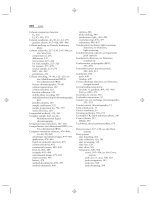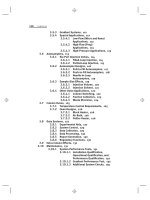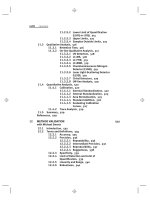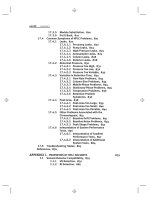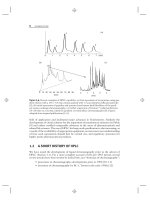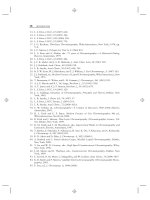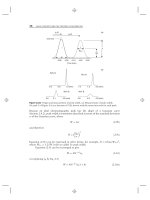Introduction to Modern Liquid Chromatography, Third Edition part 27 doc
Bạn đang xem bản rút gọn của tài liệu. Xem và tải ngay bản đầy đủ của tài liệu tại đây (190.69 KB, 10 trang )
216 THE COLUMN
0.2 0.4 0.6 0.8
Time
(
min
)
1
2
3
4
5
Figure 5.12 High-temperature separation of a pharmaceutical mixture. Sample: 1, doxy-
lamine; 2, methapyrilene; 3, chloropheniramine; 4, meclizine; 5, triprolidine. Conditions:
100 × 4.6-mm ZirChrom-PBD
column (zirconia); 20% acetonitrile/water with added
tetramethylammonium hydroxide to control pH-13; 4.2 mL/min; 140
◦
C; 2850 psi. Courtesy
of ZirChrom Separations, Inc.
low- and high-pH mobile phases (1 ≤ pH ≤ 13), and they can be used at very high
temperatures (≤ 160
◦
C) [34]. Figure 5.12 shows a separation on a zirconia column
at pH-13 and 140
◦
C. Early columns packed with polymer-coated zirconia displayed
rather poor efficiency, apparently because of poor stationary-phase mass transfer.
While their performance continues to be improved, zirconia columns are still waiting
(as of the time this book was written) for a critical application where they perform
demonstrably better than silica-based RPC columns. However, this may reflect the
present limited impact of high-temperature separation (
>
60
◦
C).
For ionizable solutes and zirconia-based columns, poor peak shapes often
result, regardless of how the packing is prepared. Consequently, when zirconia-based
packings are used with ionizable solutes, special mobile-phase additives (e.g., phos-
phate or fluoride) are required for good peak shape and reasonable values of N [34,
35]. For a sufficiently large concentration of the additive, values of N and peak shape
for basic solutes are similar to those found for alkylsilica columns (for pH ≤ 10).
At the time this book was published, somewhat poorer results were obtained for
the separation of peptides and proteins, compared to separations with alkylsilica
columns.
Zirconia-based ion-exchangers are also available commercially. A weak
anion-exchanger can be formed by coating zirconia particles with polyethyleneimine,
followed by cross-linking with 1,4-butanedioldiglycidylether. This approach pro-
duces columns that are stable from pH range 3 to 9 and can be used to separate
organic acids, inorganic anions, and highly polar compounds such as sugars.
Chemically and thermally stable, strong anion-exchange columns are also available
for separations at ≤ 100
◦
C, over the pH range of 1 to 13. These packings are
formed by cross-linking zirconia-coated polyethyleneimine with 1,10-diiododecane
or a similar compound [34].
Carbon-clad zirconia is a uniquely selective packing, compared to other RPC
columns; it is prepared by passing a reduced pressure of organic vapor over
porous zirconia at a temperature of ∼700
◦
C [34]. Carbon-clad zirconia differs
from alkyksilica packings in being more hydrophobic, is better able to separate
polar and nonpolar geometrical isomers, and is also capable of π –π interactions
5.3 STATIONARY PHASES 217
(Section 5.4.1). This packing is stable from pH 0.3 to 14 at 40
◦
C, and is thermally
stable to ≥ 200
◦
C at neutral pH. Peak shape and column efficiency tend to be poor
at lower temperatures (e.g., 35
◦
C), but these columns have been under development
for a much shorter time than silica-based columns—so future improvements seem
likely.
5.2.5.2 Alumina and Titania
RPC columns based on an alumina support were reported in the early 1980s [36],
and have since been reviewed [37]. The chemistry of the alumina surface is more
like that of zirconia than silica, and alumina columns are also stable at higher pH.
As covalently bonded alumina is not stable, coating or polymerizing a polymer onto
the surface is used in place of silane derivatization. Because of its strongly adsorptive
properties, few reversed-phase applications of coated alumina have been reported.
Unbonded alumina is not used at present for HPLC separation, but it has found a
role for sample preparation (Section 16.6.5.2).
Commercial columns packed with titania particles are also available, but these
are used mainly for normal-phase separations. Reversed-phase materials based on
titania generally show no advantages over more traditional silica- and zirconia-based
particles, so they have not achieved widespread use. On balance, silica remains by
far the most popular support, because of a better compromise among important
column properties (Table 5.5).
5.2.5.3 Graphitized Carbon
Porous, graphitic carbon (PGC) is a very different column-packing, consisting of fully
porous, spherical carbon particles that are formed from flat sheets of hexagonally
arranged carbon atoms [38, 39]. The carbon atoms have a fully satisfied valence
that results in very different retention and selectivity, compared to other columns.
PGC can be used for both reversed- and normal-phase separation, and is stable
at 1 ≤ pH ≤ 14 and ≤ 200
◦
C. However, its reduced particle strength limits the
maximum pressure that can be used with these columns.
PGC retains polar compounds by a combination of strong hydrophobic,
electronic, and dipolar interactions [38], so that polar solutes can be preferentially
retained even under RPC conditions. The selectivity of graphitized-carbon columns
is difficult to predict, compared to conventional bonded-phase columns, and this can
make method development more difficult. Also column efficiency and peak shape
can be somewhat poorer than for conventional RPC columns. However, porous
carbon shows a special ability to separate stereo- and diastereoisomers, as well
as positional isomers for which poor or no separation occurs with conventional
packings. Figure 5.13 shows a separation of hippuric acid and its methyl-substituted
isomers on a PGC column, using a low-pH mobile phase.
5.3 STATIONARY PHASES
The column stationary phase determines retention and selectivity (Sections 2.3, 5.4),
and it must meet certain practical requirements, for example, acceptable stability,
218 THE COLUMN
1
05
Time
(
min
)
10
2
3
4
Figure 5.13 Separation on a graphitized-carbon column of hippuric acid and its
methyl-substituted isomers. Sample: 1, 2-methylhippuric acid; 2, hippuric acid; 3,3-methyl-
hippuric acid; 4, 4- methylhippuric acid. Conditions: 100 × 4.6-mm Hypercarb column;
mobile phase is 30% acetonitrile, 30% isopropanol, and 40% water with 0.1% TFA;
1.0 mL/min; 25
◦
C. Courtesy of Thermo Scientific.
reproducibility, peak shape, and column efficiency N. In this section we review the
preparation, nature, and properties of different stationary phases—apart from their
selectivity, which is discussed in the following Section 5.4. Most stationary phases
are organic in nature, either covalently bound to or (rarely) mechanically deposited
on the particle. In some cases the surface of the unmodified particle is the stationary
phase, for example, unmodified silica for use in normal-phase chromatography
(including hydrophilic interaction chromatography, HILIC). We will assume that
we start with a silica particle, prior to adding the stationary phase. Procedures used
for other supports were referred to in the previous Sections 5.2.3–5.2.5.
5.3.1 ‘‘Bonded’’ Stationary Phases
RPC packings usually are made by covalently reacting (‘‘bonding’’) an organosilane
with the silanols on the surface of a silica particle to form the stationary phase or
ligand R:
X
3
−Si−R +
≡
Si−OH →
≡
Si−O−Si(X
2
)−R + HX (5.1)
(silane) (silanol) (final phase)
The functional group X is often –Cl or –OEt, and/or –CH
3
(Fig. 5.14), in which case
the reaction by-product HX is HCl or ethanol. Silanes substituted with other groups
X are also used, as will be discussed. Some bonded-phase packings are made via the
monofunctional reaction of Figure 5.14a. Here a single silane reagent reacts with a
single, surface-silanol group, for example, chlorodimethyl-octadecylsilane (where the
ligand R
=
C
18
) reacts to form a monomeric C
18
column. Other commercial packings
are formed from a surface reaction with a trifunctional (or difunctional) silane, as
illustrated in Figure 5.14b, c (although two silane-silica bonds are shown here, three
such bonds are also possible). Depending on the reaction conditions, polymeri-
zation of the stationary phase can result in the latter case (use of a difunctional
5.3 STATIONARY PHASES 219
Si−OH + Cl−Si(CH
3
)
2
R
Si−O−Si(CH
3
)
2
−R + HCl
(a)
(b)
Si OH
Si OH
+ Cl
3
Si-R
Si O
Si O
Si(Cl)−R + 2 HCl
(c)
+ (EtO)
3
Si−R
Si O
Si O
Si(OEt)−R + 2 EtOH
Si OH
Si OH
(d)
Si-OH + (EtO)Si(CH
3
)
2
−R
Si−O−Si(CH
3
)
2
−R + EtOH
Figure 5.14 Synthesis of various bonded-phase column packings by the reaction of a silane
with silica. (a, d), Monomeric packings; (b, c), potentially polymeric packings.
or trifunctional silane), yielding a polymeric stationary phase or column (not to be
confused with a ‘‘polymer column’’; Section 5.2.3). As we will see, the properties of
monomeric and polymeric columns are significantly different in important respects.
Several different kinds of silane–silica reactions have been used to prepare
HPLC columns, as illustrated in Figure 5.15. Figure 5.15a illustrates a ‘‘vertical’’
polymerized phase that results from the reaction of a di- or trifunctional silane (as
in Fig. 5.14b or Fig. 5.14c). In the example of Figure 5.15a, the silane that initially
reacts with the surface further reacts with one or more additional silane molecules
to give a polymeric phase (in the presence of water; see below). These phases tend to
be more stable than monomeric phases at both low and high pH, as the ‘‘heavier’’
surface coverage of these packings slows down the attack of the mobile phase on
both the silica and the ligand–silica bond. However, packings of this type tend
to be less reproducible in terms of retention and selectivity because of variable
(inadequately controlled) silane polymerization.
‘‘Horizontal’’ polymerization with self-assembled silanes (C
3
plus C
18
) yields
the general structure shown in Figure 5.15b. Here Si atoms of adjacent silanes are
connected to each other through oxygen atoms (siloxane linkages, Si–O–Si), while
each silane is connected to the silica via another siloxane bond. Columns prepared
in this way have been reported to exhibit superior stability in both low- and high-pH
applications [40], but no commercial columns of this type had been announced at
the time this book went to press.
The monomeric phase of Figure 5.15c is most widely used for RPC columns;
packings with several different functional groups (ligands) are commercially available
(Section 5.3.3, Table 5.7); the silane side-groups are usually methyl groups, as in
Figure 5.15c. These packings are commonly prepared by reacting dimethylchloro-
or dimethylethoxy-silanes with the silica support (Fig. 5.14a, d): one silane molecule
reacts with one silanol group. The advantage of this one-to-one reaction is that a
220 THE COLUMN
Si Si Si
O OH O OH O
Si Si Si Si Si
Monomeric
(dimethyl-substituted)
(c)
Si Si
OOHOHOOH
Si Si Si Si Si
Monomeric
(steric protected)
(d)
methyl
i-butyl
Si
Si-OH
Si-OH
OOOH
OO
Si Si Si Si Si
O
OH
Polymeric
Vertical polymerization
(a)
Si Si Si Si Si
OO
O
O
O
Si Si
Si
Si Si
OO OOOO
Polymeric
Horizontal polymerization
(b)
Figure 5.15 Some alternative bonded phases based on different reaction conditions. Adapted
from [40].
reproducible, well-defined bonded phase results. Packings made in this way often
exhibit the highest column efficiency because of rapid diffusion of the solute into
and out of the less-crowded stationary-phase layer. Conversely, packings with
multifunctional, highly polymerized stationary phases can exhibit slower solute
diffusion and lower values of N, especially at higher flow rates.
The silane reactions of Figure 5.14c, d are typically carried out with
alkoxysilanes that have reactive R-groups (ligands) such as –C
3
–NH
2
or
–C
3
–O–CH(OH)–CH
2
OH (to give an amino or diol column, respectively).
Stationary phases with certain ligands (e.g., those containing reactive amino or
hydroxyl groups) cannot be prepared from chlorosilanes because of undesirable
secondary reactions of the ligand. These reactive stationary phases are instead made
from alkoxysilanes, as in Figure 5.14c or d. Alkoxysilane reactions are somewhat
slower than those with chloro- and dimethylamino-silane, generally requiring longer
reaction times and higher silane concentrations for equivalent reaction yields.
The sterically protected silane stationary phase of Figure 5.15d [41–43] is
a variation of the monomeric phase of Figure 5.15c, where the methyl groups of
the silane in Figure 5.15c are replaced by i-propyl or i-butyl in Figure 5.15d.The
latter large, bulky side-groups interfere with the hydrolysis of the bonded silane, as
illustrated in Figure 5.16b andcomparedwithFigure5.16a. Each Si–O–Si bond is
5.3 STATIONARY PHASES 221
(b)(a)
(c)(d)
Si Si Si Si
Si Si
OOHOHOH
+ (CH
3
)
3
Si−Cl
Si Si Si Si
Si Si
O O OH OH
TMS
TMS = trimethylsilyl = (CH
3
)
3
Si−
Si
Si Si
O OH O OH O
Si Si Si Si Si
H
3
O
+
Si Si
OOHOHOOH
Si Si Si Si Si
H
3
O
+
Figure 5.16 Options for increasing the stability of alkylsilica columns. (a, b), protection of
the—Si–O–bond by a steric-protected bonded phase (for low-pH conditions only); (c, d)pro-
tection of the bonded phase by end-capping.
individually protected by the size of the two bulky side-groups in Figure 5.16b.Steric
protection is useful for separations at low pH (but not at high pH) because low pH
catalyzes the breaking of the O–Si bond [41]. Sterically protected stationary phases
are available with a variety of ligands (e.g., C
8
,C
18
, cyano, phenyl), each of which
show exceptional stability for use with low-pH mobile phases. Because low-pH
mobile phases are preferred for the separation of ionic samples (Section 7.3.4.2),
sterically protected columns are especially useful for the separation of biological
samples such as peptides and proteins. Because of the steric bulk of the protecting
silane groups, these packings have a lower surface concentration of the ligand, and
exhibit lower retention than comparable dimethyl-substituted phases—as shown by
the data of Table 5.6 for monomeric columns. Bonded bidentate-silane stationary
phases (as in Fig. 5.14b) are more stable for high-pH applications [44].
Prior to the silane reaction, a fully hydroxylated silica will have a surface-silanol
concentration of ≈ 8 μmol/m
2
. However, the size of an attached silane results in
some overlap of adjacent silanols, which inhibits their further reaction with the
silane reagent. The ligand concentration for a fully reacted packing will therefore
seldom exceed 4 μmol/m
2
(leaving half or more of the original silanols unreacted).
As shown in Table 5.6, as the chain length or cross section of the silane increases, the
percentage of reacted silanol groups (and ligand concentration) decreases. Almost
50% of the silanol groups remain unreacted for the smallest silane (trimethyl).
Although unreacted silanols may be inaccessible to a reacting silane, they may still
be able to interact with the solute molecule (Section 5.4.1).
Polymeric phases are used (to a limited extent) because of their greater stability
and unique selectivity (Section 5.4.1.2). Whereas the preparation of monomeric
phases (as in Fig. 5.14a) must be carried out in a water-free reaction medium,
222 THE COLUMN
Table 5.6
Effect of Silane Bonded-Phase Chain Length and Bulk on Silica Support Coverage
Bonded Phase Ligand Surface Coverage (μmol/m
2
) Reacted Silanols (%)
Trimethyl 4.1 51
Dimethyl-3-cyanopropyl 3.8 48
Dimethyl-n-butyl 3.8 48
Dimethyl-n-octyl 3.5 44
Dimethyl-n-octadecyl 3.2 40
Sterically protected columns
Triisopropyl 2.2 28
Diisopropyl-3-cyanopropyl 2.1 26
Diisopropyl-n-octyl 2.0 25
Diisobutyl-n-octadecyl 1.9 25
polymeric phases require the presence of water during part of their synthesis. The
extent of reaction or polymerization is controlled by varying the amount of water
added to the reaction [45]. The reaction of an alkyltrichlorosilane with silica particles
is carried out in the presence of water [45].
To minimize unwanted interactions with residual silanol groups
(Section 7.3.4.2), column packings for RPC are usually endcapped,byafurther
reaction of the bonded phase with a small silane such as trimethylchlorosilane or
dimethyldichlorosilane (Fig. 5.16d). This procedure decreases the concentration of
unreacted silanols, as well as their interaction with retained solute molecules—but
does not totally eliminate silanol-solute interaction (end-capping increases
the percentage of reacted silanols by only 20–30% [46], corresponding to a
somewhat smaller decrease of unreacted silanols). Small ligands (e.g., end-capping
trimethylsilyl groups) are more susceptible to hydrolysis and loss at low pH, which
can lead to changes in retention and selectivity. On the other hand, end-capped
columns are more stable at intermediate and higher pH.
Still another kind of bonded phase is based on ‘‘type-C’’ silica. The polar
silanols of a typical type-B silica are first reacted to form a nonpolar, silicon-hydride
surface (Fig. 5.17a). The latter type-C silica can be used without further change
for either RPC or normal-phase chromatography. Type-C silica can be modified
(for RPC) by the addition of alkyl groups (Fig. 5.17b). Good reproducibility and
stability are claimed for these packings, even when used in 100% water mobile
phases over a pH range of 1.5 to 10 [47]. These packings were relatively new
at the time this book was published. Information on their properties and use
was quite limited, but they were commercially available (MicroSolve Technology;
Eatontown, NJ).
Alkyl and aromatic ligands present in a packing (including end-capping) can
be identified following their removal from the silica particle [48]. The packing is
first treated with aqueous hydrofluoric acid, which cleaves the ligand–silica bond.
The ligand reaction-product can then be characterized by GC, NMR, and/or mass
spectrometry.
5.3 STATIONARY PHASES 223
HHHH
Si
O
O
OSi Si O Si
OO
O
O
Si
H
Si
O
Si Si Si Si
(b)(a)
CH CH
Si Si Si Si
OOOO
Si Si Si
Si
OO
O
Figure 5.17 Type-C silica (a) and the resulting bonded phase (b) (bidentate C
18
).
5.3.2 Other Organic-Based Stationary Phases
5.3.2.1 Mechanically Held Polymers
As in the case of metal-oxide supports other than silica (Section 5.2.5), mechanically
held polymers such as cross-linked polystyrene and polybutadiene have been used
as stationary phases for silica-based particles [49]. Because of their poorer efficiency
and reproducibility, as well as the lack of phases with different functional groups,
little use has so far been made of these columns.
5.3.2.2 Hybrid Particles
Hybrid particles are formed by polymerizing two monomers (e.g., tetramethoxysilane
and tetraethoxysilane), to form an organic/inorganic structure as in Figure 5.18.
The chemistry for these materials was first introduced by Unger et al. [50] in
R
SiEt O
O
Si
Et O
O
Et O
Si
Si
O
O
R
O
O
O
n
Polyethoxyoligosiloxane Polymer
OEt
Si
EtO OEt
OEt
R
Si
EtO OE
t
OEt
+
Figure 5.18 Synthesis of organic/inorganic hybrid particle. Courtesy of Waters Corporation.
224 THE COLUMN
1977, and later developed more fully by Waters Corporation. Hybrid particles are
formed using a silane that contains hydrolytically stable Si–C bonds. These stable
bonds are part of the matrix, which improves the pH stability of such packings
relative to silica-based packings. The first such packing was prepared from a 2
to 1 ratio of tetraethoxysilane and methyltriethoxysilane (XTerra). Later a hybrid
packing with further improved pH stability was created from tetra-ethoxysilane and
ethyl-bis-triethoxysilane (XBridge). These particles possess excellent stability when
used with both low- and high-pH mobile phases, as well as a mechanical strength that
allows their use at pressures to 15,000 psi. As with silica particles, hybrid particles
can be derivatized with various ligands (C
8
,C
18
, etc.) [51]. Hybrid packings are
especially useful for the high-pH separation of non-ionized basic solutes—allowing
improved peak shapes and larger sample weights (Section 15.3.2.1).
5.3.2.3 Columns for Highly Aqueous Mobile Phases
RPC separations of very polar samples may require small values of %B in order
to achieve values of k ≥ 1, although other means exist for increasing the retention
of such samples (Sections 6.6.1, 7.3.4.3, and Chapter 8). When RPC is used with
low values of %B, several problems may be encountered: a decrease in sample
retention with time, decrease in values of N, and long equilibration times when
changing from one mobile phase to another [52, 53]. This behavior is the result of
stationary-phase de-wetting (sometimes incorrectly called phase collapse), with the
consequent expulsion of mobile phase from the pores of the particle [54, 55]. Thus
the pressure P required to force the mobile phase into a particle pore of diameter
d
pore
is
P =
−4γ cos θ
d
pore
(5.2)
where γ is the surface tension of the mobile phase, and θ is the contact angle between
the stationary and mobile phases. The value of θ is
>
90
◦
for a C
18
stationary phase
and water as mobile phase, meaning that pressure is required to force water into
the pores. If the pressure P is insufficient to force a highly aqueous mobile phase
into all the pores of the particle, solute molecules will be excluded from these pores.
The required pressure increases for more hydrophobic columns (C
30
, more pressure;
C
1
less pressure), and for particles with smaller pores. P also increases for smaller
values of %B. Dewetling and the loss in retention can be reversed by flushing the
column with methanol or another organic solvent [56].
Problems from column de-wetting arise mainly when the column is
de-pressured. If the column is initially filled with mobile phase of
>
50% B, all
pores will be filled with mobile phase at pressures normally used in HPLC. This
will commonly be the case when beginning a series of RPC separations, as it is
recommended to store the column with 100% acetonitrile as fill solvent. If the
mobile phase is then changed to a lower value of %B while maintaining the column
pressure, de-wetting is less likely to occur. However, when planning to carry out
RPC separations with <5% B, it is advisable to select a column that is less likely
to undergo de-wetting (shorter ligand lengths, more polar ligands, lower ligand
concentration; see also Section 5.4.4.2).
5.3 STATIONARY PHASES 225
In an attempt to solve the problem of de-wetting, special ‘‘aqueous
reversed-phase’’ packings have been developed that allow the use of mobile phases
that contain
>
95% water. Examples of this kind include columns with embedded
polar groups, polar end-capping (indicated by such terms as ‘‘polar,’’ ‘‘AQ,’’
‘‘hydrosphere,’’ ‘‘aqua,’’ ‘‘aquasil’’), or a lower concentration of the alkyl ligand.
Wide-pore columns or columns with a shorter ligand are also less susceptible to
de-wetting, but such columns are also less retentive and therefore less useful for the
RPC separation of very polar samples.
5.3.3 Column Functionality (Ligand Type)
Apart from the differences in RPC stationary phases described in Sections 5.3.1
and 5.3.2, the chemical composition of the ligand can vary. Ligands for several,
commercially available column types are described in Table 5.7 and illustrated in the
Table 5.7
Functional Groups Found in HPLC Stationary Phases
Functional Group Mode
a
Comment
C
3
RPC Used primarily for separations of
proteins
C
4
RPC
C
5
RPC
C
8
RPC Most commonly used columns; similar
retention and selectivity
C
18
RPC
C
30
RPC Used mainly for carotene separation
Phenyl RPC Commonly used column, mainly for a
change in selectivity
Embedded-polar-group
(amide, carbamate,
urea)
RPC Commonly used column, mainly for or
use with water-rich mobile phases
(<5% B), to improve peak shape for
basic solutes, or for a change in
selectivity
Perfluorophenyl (PFP) RPC Less commonly used column, mainly
for a change in selectivity
Cyano RPC, NPC Less commonly used column
NH
2
(amino) RPC, NPC, IEC Less commonly used column
Diol RP, NP, SEC Mainly used for SEC
WAX IEC Used mainly for separating inorganic
ions or large biomolecules
(Section 13.4.2)
WCX IEC
SAX IEC
SCX IEC
a
RPC, used for reversed-phase chromatography; NPC, used for normal-phase chromatography; IEC, used
for ion-exchange chromatography; SEC, used for size-exclusion chromatography.
